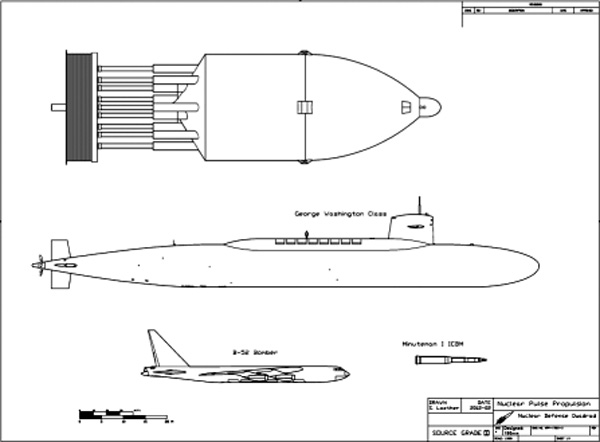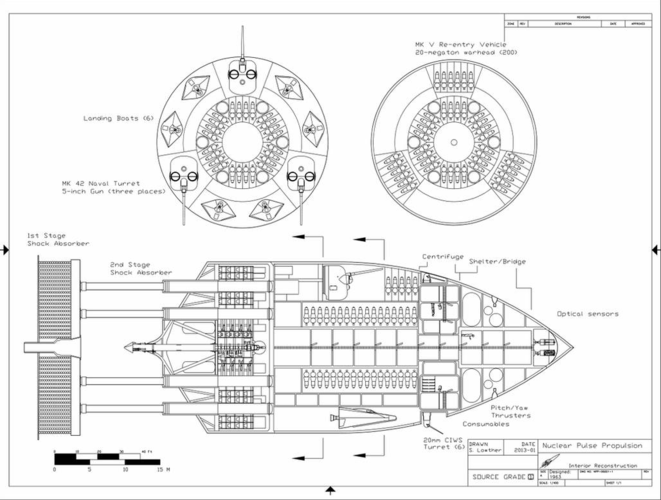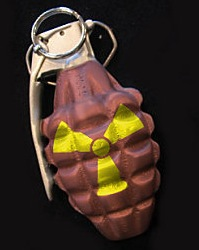uselesschain
ACCESS: Restricted
- Joined
- 10 November 2020
- Messages
- 4
- Reaction score
- 12
(Shamelessly stolen from the website atomic rockets)
 One notional 1959 concept for a large military Orion was the “doomsday weapon" idea. Instead of one Orion carrying a large number or weapons, able to rain down devastation on many separate targets, the idea was to equip one Orion with one single weapon, a hydrogen bomb of immense size and capability. While data is sketchy. the payload would be a single nuclear device with a mass of 1,650 tons. Yield is not readily available. but is estimatable. Numbers vary from source to source, but maximum yield-per-bomb-mass seems to be around five megatons per metric ton of bomb based on current technology; this could increase to well above 100 megatons per ton of bomb for a highly efficient nearly pure-fusion lithium deuteride device. But assuming 5 megatons per ton, 1,650 tons of bomb yields 8,250 megatons, or 8.25 gigatons. This falls far short of the 100 million megaton “yield” of the dinosaur-killing asteroid or comet from the end of the Cretaceous era, but would still wreak vast havoc upon the Earth. A 1,650 metric ton bomb composed chiefly of lithium deuteride would have a volume of about 2,115 cubic meters, although a large hydrogen bomb probably cannot be made as simple as a block of lithium deuteride with a fission trigger in it. In reality, it would very likely be a structurally complex device.
One notional 1959 concept for a large military Orion was the “doomsday weapon" idea. Instead of one Orion carrying a large number or weapons, able to rain down devastation on many separate targets, the idea was to equip one Orion with one single weapon, a hydrogen bomb of immense size and capability. While data is sketchy. the payload would be a single nuclear device with a mass of 1,650 tons. Yield is not readily available. but is estimatable. Numbers vary from source to source, but maximum yield-per-bomb-mass seems to be around five megatons per metric ton of bomb based on current technology; this could increase to well above 100 megatons per ton of bomb for a highly efficient nearly pure-fusion lithium deuteride device. But assuming 5 megatons per ton, 1,650 tons of bomb yields 8,250 megatons, or 8.25 gigatons. This falls far short of the 100 million megaton “yield” of the dinosaur-killing asteroid or comet from the end of the Cretaceous era, but would still wreak vast havoc upon the Earth. A 1,650 metric ton bomb composed chiefly of lithium deuteride would have a volume of about 2,115 cubic meters, although a large hydrogen bomb probably cannot be made as simple as a block of lithium deuteride with a fission trigger in it. In reality, it would very likely be a structurally complex device.
Such a massive weapon would of course be a last ditch weapon, one to be used only when the United States was threatened with extermination. The idea was that the mere existence of such a weapon would deter the Soviets from doing anything foolish. The bomb would be detonated well over the Soviet Union, several hundred miles out; it would not be blast but radiation which would do the job. However, weapons of this size were so far beyond contemporary understanding that nobody really knew exactly what would happen if the bomb was touched off. Would the high energy radiation simply sleet through the atmosphere, only being absorbed in the ground or structures? Would it be largely absorbed in the upper atmosphere, which would as a consequence be heated well past incandescence… essentially setting the sky on fire? Whatever the effects were, they would be spread over most of a hemisphere.
Such a massive weapon would of course be a last ditch weapon, one to be used only when the United States was threatened with extermination. The idea was that the mere existence of such a weapon would deter the Soviets from doing anything foolish. The bomb would be detonated well over the Soviet Union, several hundred miles out; it would not be blast but radiation which would do the job. However, weapons of this size were so far beyond contemporary understanding that nobody really knew exactly what would happen if the bomb was touched off. Would the high energy radiation simply sleet through the atmosphere, only being absorbed in the ground or structures? Would it be largely absorbed in the upper atmosphere, which would as a consequence be heated well past incandescence… essentially setting the sky on fire? Whatever the effects were, they would be spread over most of a hemisphere.






